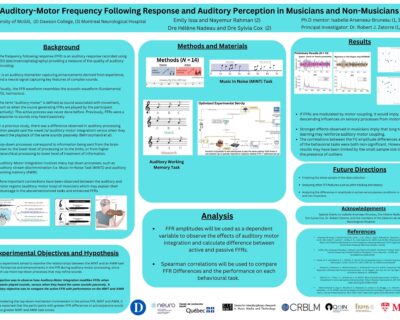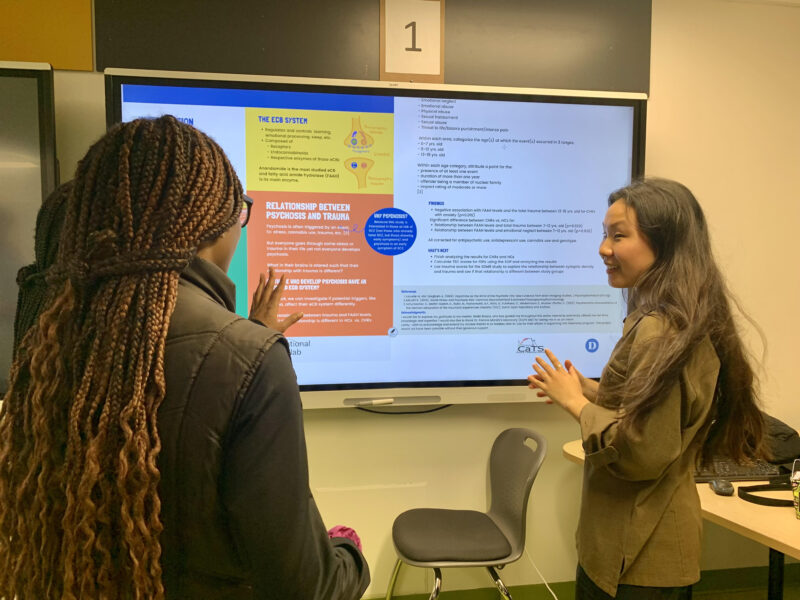Students share summer neuroscience research projects at Montreal labs
Thirteen Dawson students spent their summer working on real research projects in various fields of neuroscience.
There were eight projects in partnership with Polytechnique/Ste-Justine, MNI, Douglas Institute, McGill departments of Physiology and of Pharmacology and Therapeutics. According to Neuroscience Research Group coordinator Hélène Nadeau: “some projects used images from dMRI, EEG, MRI, fMRI, MR spectroscopy, or PET modalities to probe questions related to the health of neonates, to audition in the normal population, or to pathologies such as schizophrenia, multiple sclerosis, or Alzheimer’s disease.
“Other projects relied on experiments on mice or rats, to better understand physiological mechanisms related to pathologies. In the course of the academic year, several teams worked on a large array of projects combining behavioural and EEG data.”
Three of the students shared their projects in interviews with the Communications Office.
Health Science student Emily Issa on her auditory research comparing musicians and non-musicians
Communications Office: Please describe the research you helped conduct.
Emily Issa: I helped conduct research studying auditory-motor integration and auditory working memory in two groups of participants, musicians and non-musicians, at the Zatorre Lab in the Montreal Neurological Hospital. This experiment entailed comparing the results of each participant’s frequency following response (FFR), which is an auditory response recorded using electroencephalography (or EEG), and their performance on two auditory perception tasks.
My partners were my Neuro mentor (PhD candidate) Isabelle Arseneau-Bruneau, Dawson mentors Dr. Hèlène Nadeau and Dr. Sylvia Cox, fellow Dawson student Nayemur Rahman, other research assistants, as well as Dr. Robert J. Zatorre, who founded the lab. My specific role in the research was research assistant, as I helped my PhD mentor collect data. In fact, once I was comfortable with the experimental protocol and background, I was able to test participants independently and collect the data for her project. I also aided in analyzing the results and even learned certain coding techniques for making correlation charts using the Matlab software.
As for current findings, since the data collection is still ongoing, the correlations determined between the two experimental categories’ frequency following responses and performance on the behavioural tasks were non-significant. However, results may have been limited by the small sample size (discussed in our poster) and the presence of outliers, so an update should be incoming once the data collection has concluded!

What did you learn from this project and from participating in the Neuroscience Research Group?
EI: My continued participation in the Neuroscience Research Group at Dawson allowed me to learn about the basics of neuroanatomy, cognitive science, and psychology.
I also gained knowledge about different complex imaging techniques used to diagnose psychological and degenerative disorders, such as Alzheimer’s.
Once I learned about these concepts, I was encouraged to begin conducting my own neuroscience experiment on students. This permitted me to gain many skills related to research, analysis of scientific literature, and data collection.
At the Neuro Hospital, I gained insight into the tireless work and important responsibilities of the PhD (research) candidates and laboratory research assistants, who work in symbiosis to collect, process, and analyze data. It was fascinating to conclude that those working in the lab originated from diverse faculties, from software engineering to neuroscience and psychology. This illustrated how multidisciplinary the field of neuroscience truly is. In fact, while its fundamental objective is to examine the intricacies behind the brain and cognitive processes, it does so by employing methods that utilize computer science, psychological theories, and even neurobiology.
I also gained immense respect for the PhD candidates who worked at the Lab. They were always there, come rain or come shine, from 9 am to 7 pm, Monday through Friday, supervising and assuring the optimal functioning of their experiments. I found that running the experimental trials, noting and analyzing the data was laborious work, so I was constantly marvelling at the PhD candidates’ dedication.
Did participating in the research project have any impact on your future study and career plans?
EI: My participation in the research project had an immeasurable impact on my future career plans, as it solidified my interest in the medical field, particularly the fields of neuroscience and neurology.
I have always aspired to be a doctor since I was a youngster (ask anyone!), but was never entirely sure which field I wanted to specialize in. In this sense, my experience at the Zatorre lab was crucial to my decision-making process, as it renewed my love of medicine while also igniting a passion for scientific research.
In fact, the hands-on experience I gained while testing participants was nonpareil, as I was able to communicate with them, guide them through the experiment, and explain some of the scientific rationale behind the many steps of the procedure. I felt like a professional researcher!
Anything else you would like to say?
EI: I would like to express my infinite gratitude towards Dr. Hélène Nadeau and Dr. Sylvia Cox, who were truly invaluable coordinators, mentors and teachers who guided my partner Nayemur and I every step of the way.
I would also like to thank and express my admiration towards my incredible, talented, and hardworking mentor Isabelle Arseneau-Bruneau at the Neuro Hospital, as well as the other members of the Zatorre lab team for being so accommodating, friendly, and helpful.
Lastly, I would also highly recommend to any students interested in the brain or the fields of cognitive neuroscience and psychology to join the Neuro extracurricular.
Enriched Health Science student Kylie Xu on her project about neonatal brain development
Communications Office: Please describe the research you helped conduct.
Kylie Xu: For this research, I was coupled with a NeuroPoly doctorate student, Erjun Zhang, although the internship took place at the CHU Saint-Justine Hospital, more precisely at TransMedTech Research Institute. My project was on the evaluation of neonatal brain tissue development using diffusion MRI. Primarily, we were interested in understanding the brain development in infants and trying to characterize the changes in white matter and gray matter of preterm and term babies. With the help of my mentor, I was able to extract diffusion tensor imaging scans in order to visualize the microstructure changes in the tissues and with further analysis, I was able quantitatively characterize the changes in diffusion in babies’ brain between 34 and 43 weeks of age. More precisely, from our results, we see that babies experience a decrease in diffusivity, suggesting an increase of tissue volume with a decrease of water content as well as the crucial development of the myelin around the axons.
What did you learn from this project and from participating in the Neuroscience Research Group?
KX: My participation in the neuroscience club as well as in the summer internship was extremely enriching. As a matter of fact, along with this opportunity, I was able to learn Python, which is a coding language. Indeed, from creating graphs to extracting diffusion tensor imaging, I had a hands on experience in the field of research and medical imaging.
Did participating in the research project have any impact on your future study and career plans?
KX: My participation in this research project more or less had an impact on my future career plan. As I am a baby lover, this project made me love these tiny creatures even more. I always wanted to work with children and this project allowed me to understand babies from an angle that I would have never thought of otherwise. It gave me more certitude in the motivation I have to help infants. Although, with this project, I understood that there were many ways that I can succour them. It definitely opened my avenue to a lot of different career choices that I completely neglected before, such as bio engineering or even neuroscience itself.
Anything else you would like to say?
KX: A GitHub page is available online regarding this project. The website includes the protocol, the results, a research report, the PowerPoint itself as well as a video of a Saint-Justine presentation conference in which I participated in that gives a summary of this research. Anyone could access it and have take a look at the analysis or even the results itself. Here is the link to the GitHub: https://github.com/zhangerjun/dMRI_data_analysis/tree/main/documents
Pure and Applied Student Josephine Kwon on her schizophrenia project
Communications Office: Please describe the research you helped conduct.
Josephine Kwon: I did my internship at McGill’s Clinical and Translational Sciences (or CaTS) research lab at the Douglas and my mentor was Belen Blasco.
I was involved in a research project exploring the relationship between the endocannabinoid (eCB) system and schizophrenia (SCZ) using position emission tomography (PET).
The specific objective was to explore the relationship between FAAH (the enzyme of the eCB anandamide) and psychosis by measuring FAAH levels in vivo in patients with first episode psychosis (FEP) and in patients who are at clinical high risk (CHR) of psychosis.
My main task in this research was to calculate trauma scores from the questionnaire the subjects filled, then find relationship between trauma and FAAH levels and compare that relationship between healthy controls (HCs), CHRs and FEPs.
The analyzes and interpretation of results are still incomplete as this is ongoing research. However, we did find:
- A negative association with FAAH levels and the total trauma between 13 and 18 years old for CHRs with anxiety (p=0.016).
Significant difference between CHRs vs. HCs for:
- Relationship between FAAH levels and total trauma between 7-12 yrs. old (p=0.029)
- Relationship between FAAH levels and emotional neglect between 7-12 yrs. old (p=0.026)
All corrected for antipsychotic use, antidepressant use, cannabis use and genotype.
Josephine Kwon internship_poster
What did you learn from this project and from participating in the Neuroscience Research Group?
JK: I learned a lot from participating in the Neuroscience Research Group. Not only did I learn so much on the endocannabinoid system, schizophrenia and psychosis, but I was also able to learn first-hand how research is conducted. More unexpectedly, through collaboration with others and the weekly presentations that we were asked to prepare, I had the opportunity to improve on communication and public speaking skills.
Did participating in the research project have any impact on your future study and career plans?
JK: Participating in the research project did impact my future study and career plans. I chose to do this internship in the hopes of having a clearer direction for my future study/career plans and I am glad that it has done that for me. Although I am still far from knowing exactly what I want to do, this experience has granted me a better understanding of what I enjoy and don’t enjoy.
Eligible students can apply in January or February for the summer program. To be eligible, they should be already involved in the extracurricular neuroscience activity or take either the Science Option course: Special Topics in Physics: Introduction to Research in Brain Imaging or the complementary course: Contemporary Issues: Introduction to Research in Neuroscience or the Psychology course: Brain and Behaviour.



